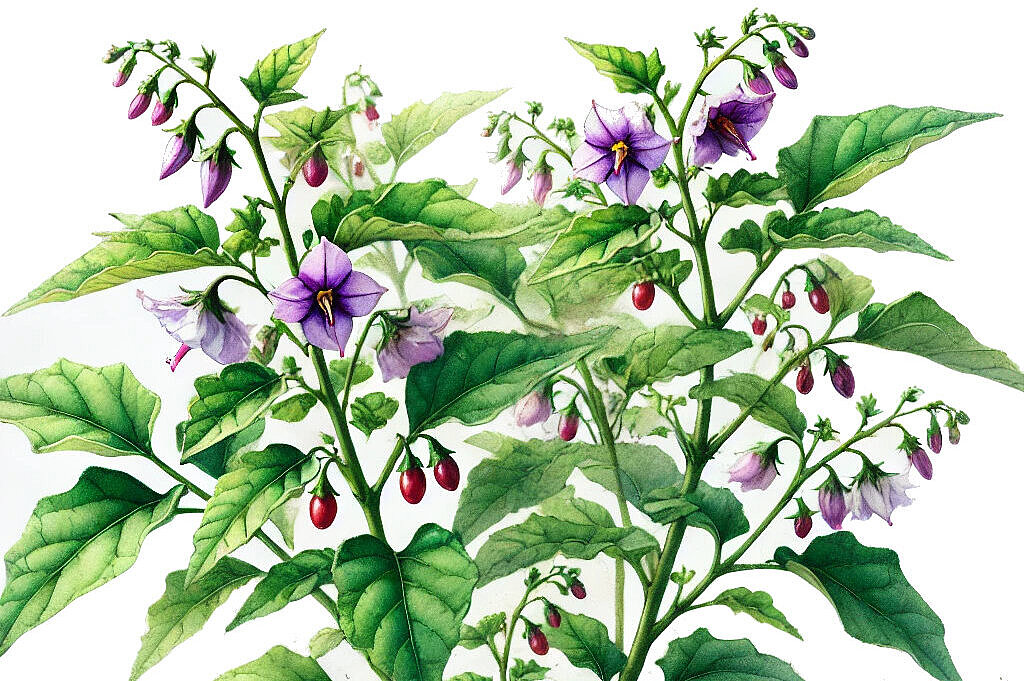Apoatropin

What is apoatropin?
Apoatropin is an alkaloid found in some plant species, including belladonna (Atropa belladonna), henbane (Hyoscyamus niger) and angel's trumpet (Datura spp.). This substance is closely related to atropine, a well-known active ingredient used in medicine to treat a number of conditions, including cardiac arrhythmias and certain types of poisoning.
Benefits of apoatropin for dogs
Medical use in controlled doses
In veterinary medicine, apoatropin, similar to atropine, could potentially be used in very controlled, minimal doses to treat certain medical conditions. For example, it could be used to relieve cramps and calm the gastrointestinal tract, but under close supervision by a veterinarian.
Research interest
Apoatropin and related alkaloids are the subject of scientific research aimed at better understanding their potential therapeutic properties. This could lead to the development of new treatment strategies for a number of diseases in dogs in the future.
Disadvantages and potential risks
High toxicity
Apoatropin is highly toxic and even at very low doses can cause severe symptoms of intoxication in dogs, including dry mouth, increased heart rate, visual disturbances, convulsions and in severe cases even death. The risk of accidental poisoning, especially if dogs have access to plants containing apoatropin, makes this substance a high risk in any environment.
Lack of specific antidotes
In the case of poisoning with apoatropin, there is no specific antidote, which complicates treatment and emphasizes the need for immediate and competent veterinary care.
Legal and ethical concerns
Due to its high toxicity and associated risks, the use of apoatropin in veterinary medicine is strictly regulated. Its use without proper authorization and monitoring raises serious legal and ethical issues.
Apoatropin is a prime example of how substances found in nature can be both potentially beneficial and extremely dangerous. While the possibility exists that controlled, medical applications of apoatropin could be developed in the future, the risks currently far outweigh the benefits. It is of utmost importance for dog owners and veterinarians alike to be aware of the dangers that apoatropin and similar substances pose and to always ensure that the health and well-being of the dog is the top priority. In any case, curiosity or interest in the use of such substances should never outweigh the caution that is required when it comes to the safety of our four-legged friends.
Properties 10
Are you looking for other ingredients with a specific property?
Just click on them to find more.
If you notice any signs of hypersensitivity or poisoning in your dog, you should see your vet immediately. We are not a substitute for a vet, but we try to be as accurate as possible. Every dog reacts differently and we recommend you get a second opinion or consult your vet if in doubt.
Stay healthy and take good care of your four-legged friend!😊
Similar to Apoatropin
Hyoscyamine is a chemical compound that occurs in nature as (S)-hyoscyamine. This is the biologically active form of the substance, which is found in datura, mandrake, angel's trumpet, belladonna...
Atropine is one of the so-called anticholinergics, which means that it inhibits the effect of acetylcholine, a messenger substance in the nervous system. Acetylcholine is involved in many processes...
Scopolamine is a so-called parasympatholytic, which means that it blocks the receptors for acetylcholine at the ends of the nerve fibers that originate from the parasympathetic nervous system. The...
Tropanols are a class of organic compounds that occur naturally in some plant species of the nightshade family (Solanaceae), such as belladonna (Atropa belladonna), angel's trumpet (Brugmansia) and...



